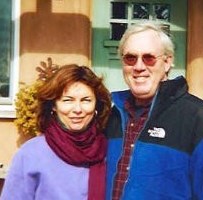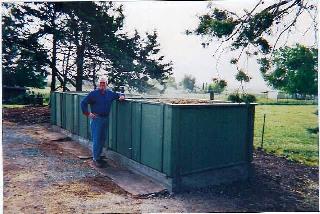Jack Chambers, a commercial worm grower, recalls the transitions of his worm farm since start-up and explains why this fledgling industry is ready to attain its full potential.
 "I first learned about earthworms and vermicomposting from Mary Applehof of Flowerfield Enterprises, who wrote the book, Worms Eat My Garbage, in the 1980’s. I was intrigued. In 1992, I visited a local worm farm in Sonoma, California on a friend's recommendation. Three months after my first visit, my wife, Lois, and I decided to buy it. The owner was ready to retire and wanted someone to continue the business which he had started in 1970.
"I first learned about earthworms and vermicomposting from Mary Applehof of Flowerfield Enterprises, who wrote the book, Worms Eat My Garbage, in the 1980’s. I was intrigued. In 1992, I visited a local worm farm in Sonoma, California on a friend's recommendation. Three months after my first visit, my wife, Lois, and I decided to buy it. The owner was ready to retire and wanted someone to continue the business which he had started in 1970.
After purchasing the farm, I connected with several master composters around the San Francisco Bay Area and began to offer a discount to people who had taken composting classes. Sonoma Valley Worm Farm began shipping worms for vermicomposting in 1994.
Also in 1994, I heard Dr. Clive Edwards of Ohio State University talk about continuous flow technology. Continuous flow technology rests on the principle that red worms (Eisenia fetida) like to process material in the top several inches of a compost bin. Basically, you feed the bin on the top, slice castings off the bottom, and the castings fall through a mesh screen to the floor and are then collected, dried and screened.
I visited Oregon Soil Corporation in 1995 and saw Dan Holcombe’s reactor. Dan was processing food waste, while we were using dairy manure as a feedstock. I wanted to continue using dairy manure; however, I was concerned that putting it directly into a reactor could cause the reactor to heat up and subsequently kill the worms.
Meanwhile, another development was taking place at Ohio State University. Worm castings were undergoing continual plant test trials. The results were consistent and encouraging. The trials showed that adding between 10-20% worm castings to a soil blend brought considerable growing benefits to plants. The researchers found more blooms per plant, greater root mass and high microbial counts in castings.
In the fall of 2000, I attended a second international worm conference in Kalamazoo, Michigan, hosted by Applehof. There, I saw a video showing a reactor developed by Dr. Scott Subler of Ohio State which was using precomposted dairy manure as a feedstock – and it was the moment that changed everything for me. His composting design was simple and elegant.
By feeding precomposted dairy manure to the worms, Dr. Subler was able to take a good deal of the heat energy out of the manure. This helped prevent the reactor from overheating and killing off the worms. Also, precomposting eliminated both weed seeds and pathogens from the feedstock.
Returning to California, I sent several worm casting samples to Elaine Ingham’s laboratory, Soil Foodweb, Inc. in Eugene, Oregon. Her results showed that worm castings at the bottom of the windrow had some anaerobic conditions due to the high moisture content necessary to grow worms. The combination of high moisture content and no airflow at the base of the windrow caused the anaerobic conditions to occur.
I realized that by adopting the reactor technology, I would solve several problems with my vermicomposting and, at the same time, would be able to process more material faster. My windrow system took eight months to a year to make high-quality castings. The reactor takes 40 to 60 days to process material.
I attended a compost tea seminar in the Sonoma Valley in June 2001. There, I met Vicki Bess of BBC Laboratories based in Tempe, Arizona. Together, we began a testing program for our vermicomposting with the BBC; checking for pathogens and microbial activity. These tests have shown both high microbial counts and strong microbial diversity in the worm castings.
Precomposting the separated dairy manure remained a challenging problem, given the amount of time and effort that it required. I developed a system of filling plastic bins with manure and turning them with my forklift whenever the temperature reached 140F. This method required several turnings within a 14 to 20-day period. As the worm population in my vermicomposting reactor became fully established, the rate of manure consumption also grew and my precomposting method became an obvious limiting factor.
In December 2001, Jim Jensen, a friend and fellow worm farmer, referred me to Peter Moon of Price-Moon Enterprises, Inc. in Snohomish, Washington. Over the years, Peter had developed many large-scale compost facilities for all varieties of organic wastes. Since the mid-1990’s, his focus has been on setting up small, medium and large-scale facilities to better manage livestock wastes, with an emphasis on dairy, horse manure, and vermicomposting.
 After visiting Peter In February 2002 and seeing his prototype, I constructed one of his aerated bin systems at our worm farm in Sonoma. This has proven to be the missing link that I needed to optimize the time / temperature requirements for precomposting the dairy manure and simplify the precomposting process.
After visiting Peter In February 2002 and seeing his prototype, I constructed one of his aerated bin systems at our worm farm in Sonoma. This has proven to be the missing link that I needed to optimize the time / temperature requirements for precomposting the dairy manure and simplify the precomposting process.
My early projections suggest that my aerated bin will produce precomposted manure in approximately 10 days and will enable me to double my production rate of high-quality worm castings with the addition of a second reactor. In addition to being simple to operate, the aerated bin system saves me between 8 and 12 hours of work each week.
The 1990’s were a very eventful decade for vermicomposting. University research showed through their plant trials that worm castings have great benefits for plant growth. The soil microbiologists came up with new testing methods that confirm the microbial content of worm castings. Aerated bin precomposting enables us to efficiently destroy weed seeds and pathogens present in the raw feedstock materials. The flow through reactor has the potential to revolutionize worm casting production.
I believe that in this decade we will see the worm industry go from the fledgling state it is in today to a soaring future where it will grow and attain its full potential."
Jack and Lois Chambers are co-owners of TerraVesco (fka Sonoma Valley Worm Farm) in Sonoma, California.
The previous discussion includes excerpts from an article in the February 2002 issue of BioCycle magazine (Page 34). Many thanks to Jack and Lois for allowing us to include their experiences and testimonial on this page.